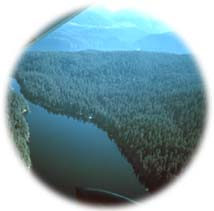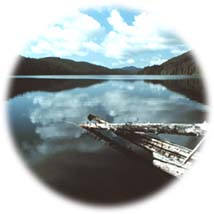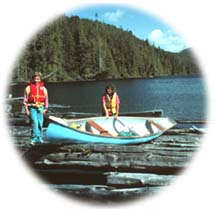
On southern Vancouver Island's Pacific coast an enclosure of high ridgelines created a rainforest sanctuary, protecting it from the outside world. Called the Nitinat Triangle because of its geographic shape, this area contained three glistening jewels within its hidden watershed: Hobiton, Squalicum, and Tsusiat Lakes. Their shores were sheltered beneath ancient stands of giant red cedar and Douglas fir.  For millennia a timeless forest had thrived untouched in this secluded valley. Reaching skyward 120 feet and 60 feet in circumference, the individual trees at Nitinat were very old - 300, 500, even 1,000 years of age. From the deep-shaded fern floor to the lofty spires where white-headed eagles perched, this was the original Earth as it had evolved since the beginning. Here the primeval energy of creation still resonated from the land - Nature's flow, pure, pristine...sacred.
For millennia a timeless forest had thrived untouched in this secluded valley. Reaching skyward 120 feet and 60 feet in circumference, the individual trees at Nitinat were very old - 300, 500, even 1,000 years of age. From the deep-shaded fern floor to the lofty spires where white-headed eagles perched, this was the original Earth as it had evolved since the beginning. Here the primeval energy of creation still resonated from the land - Nature's flow, pure, pristine...sacred.
Since the passing of the last Ice Age 11,000 years ago, life in the British Columbian rainforest had become intricately intertwined. Everything supported everything else. The great trees that had endured here for centuries were fed by nutrients that had accumulated in the deep, wet soils. Their roots soaked up this richness from the forest floor, enabling the great conifers to grow tall and huge. By maturity their crowns reached beyond the canopy into the often misty sky. But nothing is forever, not even rainforest cedars.
Gradually, as they got even larger, the beginning of their end was presaged. Decay commenced, and slowly the heartwood of the trees was eaten away by millions of microbes, fungi, and insects. This action was relentless so that eventually a seemingly healthy giant was reduced to a hollow shell of its original self. With the core gone, so, too, was the old tree's strength. Then it would wait through the final seasons for the inevitable end.
One evening, 600 years ago, a massive storm swept in from the Pacific to hammer the mountains of Nitinat. Powered by subtropical energy, the force of the wind was colossal. For hours it wailed through the forest, causing trees to strain in tremendous arcs. And so it was that down on the flats near the outlet of Hobiton Lake a decayed but valiant veteran could resist no longer. First, with a creaking and then a thunderous crash, the ancient cedar smashed to the ground, victim of a gale's fury.
"Since the passing of the last Ice Age 11,000 years ago, life in the British Columbian rainforest had become intricately intertwined. Everything supported everything else."
The next day the winds dropped and all was quiet. After a life lived so tall, the fallen monarch now rested in the shadows of the forest floor. Over time its shell of trunk, like the long gone heartwood before, also came to be colonized by fungi and countless microbes. Slowly, over the decades and then the centuries, these life-forms changed the wood into soil, transforming the fallen giant into a foundation for the future.
The years came and went, and with them many winter storms. During one of these tempests, an especially strong gust dislodged a cedar cone from high above. It dropped through the canopy and landed on the decaying cedar. Soon a seed germinated and rootlets extended into the nurse log's soil. The date was October 12, 1492. On the distant side of North America, Christopher Columbus rowed ashore to discover his New World. Stepping out of his boat, he was met by a people who had long lived there . . . .
 At Nitinat native peoples also made their home within the rainforest. Their ancestors were as much a part of the spirit of this place as the cedars. They called themselves Dididat, and they had been there, according to the traditional stories, since Creation. And throughout all these thousands of years of human-forest coexistence little had changed.
At Nitinat native peoples also made their home within the rainforest. Their ancestors were as much a part of the spirit of this place as the cedars. They called themselves Dididat, and they had been there, according to the traditional stories, since Creation. And throughout all these thousands of years of human-forest coexistence little had changed.
Each fall they gathered at the outlet of Hobiton Lake to fish for the spawning salmon that returned upriver. Back behind the camp was a massive tree trunk that the children liked to clamber on. One year small feet running atop the log almost stepped on a little cedar seedling only inches high.
By now, thousands of miles to the east, European traditions were being introduced to the New World. The felling of the great hardwood forests of eastern United States and Canada had begun to make way for first settlements: the Virginia colony, Annapolis Royal. These initial clearings of the white man seemed so inauspicious, just tiny, stump-bound openings amid an endless ocean of forest in the North American wilderness.
Yet human "progress" is inexorable and cumulative. So, even as the cedar growing on the fallen log at Hobiton was a mere 20-foot sapling, its young roots embracing the old decaying trunk, the first pioneers on the Atlantic seaboard moved out from their rude footholds to clear more fields and log trees. The clearings began to converge and increasingly eat into the seemingly infinite forests. Over the decades that followed, the settlements expanded into colonies. Later 13 of these colonies came together to undertake revolution, ultimately forging the United States, a new democracy, out of the North American wilderness.
"As the tree approached maturity, its topmost needles reached the canopy and the light, where the vista was a swirling ocean of green washed by winds inbound off the Pacific."
Subsequently the boundaries of this young nation - indivisible under God - spread incessantly down into the Louisiana country, out across the Great Plains to the Oregon territory, up the California coast, and finally to the distant land of Alaska. And with every expansion there was yet another new surge of pioneers, another frenzy of settlement, a further pushing back of the frontier, and an ever-increasing felling of forests.
North of the Forty-ninth parallel, in Canada, the British Empire persisted. But here, too, the trees, the great hardwood forests of southern Ontario and Quebec, fell to the settlers' axes. In Nova Scotia the white pine forests were logged out to provide masts for the British navy. At Nitinat the Hobiton Cedar reached upward toward the canopy and sunlight. Like a gangly, fast-growing teenager, it was still spindly, perhaps two feet in diameter and 80 feet tall. Now, as it grew, an occasional sailing ship would drift past - explorers and fur traders engaged in discovery, and the first West Coast exploitation.
 Decades passed, and the Hobiton Cedar added more height. As the tree approached maturity, its topmost needles reached the canopy and the light, where the vista was a swirling ocean of green washed by winds inbound off the Pacific. Often the air would become quiet as clouds wreathed the arboreal columns and an endless rain descended.
Decades passed, and the Hobiton Cedar added more height. As the tree approached maturity, its topmost needles reached the canopy and the light, where the vista was a swirling ocean of green washed by winds inbound off the Pacific. Often the air would become quiet as clouds wreathed the arboreal columns and an endless rain descended.
But Manifest Destiny couldn't be denied, and across the continent railways were built. As the steel was extended farther from the Atlantic and closer to the Pacific, more and more people arrived. They joined in the Herculean epic of transforming the landscape to their needs. The eastern hardwood forests retreated from the valleys to the uplands, while the sweeping prairies lost their buffalo, were fenced, and rendered into checkerboard squares.
At Nitinat the Hobiton Cedar was now centuries old. Still, with each passing storm, with every welcome interlude of sun, with every season - cool, then warm, then cool again - the big tree added girth, becoming larger and ever more majestic. And still the salmon spawned in the lakes where the Dididat set their nets.
Elsewhere across North America the pace of development quickened. The population grew, technology intensified, and the 20th century dawned. The completion of a new canal across the Panamanian isthmus brought Europe and New England much closer to the West Coast. Now it became economic to chop down the big trees of the Pacific coast, mill them into lumber, and ship them off to the eastern United States and Europe. The building of the canal was timely, since the great forests of eastern North America, like their once great counterparts in Europe, had become devastated through ruthless overcutting. The infinite timberlands had been reduced to a patchwork of finite remnants. They were wilderness no longer.
"To the big cedar at Hobiton Lake, eternity and the infinite seemed intact . . . until the morning when the far-off, faint whine of a chain saw first drifted across the guardian ridges."
Such devastation, such tragedy. The forest lands of the previously wild continent had been ravaged with stunning speed. In only 500 years of European settlement a life system 4.5 billion years in evolution had been ruthlessly exploited, in many places to extinction. All the while at Nitinat the Hobiton cedar and the other old trees stood oblivious to the destruction suffered across the continent during their lifetimes. Rather, in silence, they witnessed another cycle of seasons and stars as the Earth tracked once again around the sun. To the big cedar at Hobiton Lake, eternity and the infinite seemed intact . . . until the morning when the far-off, faint whine of a chain saw first drifted across the guardian ridges.
The advent of the gasoline-powered chain saw and its ability to allow one man to topple a centuries-old rainforest monarch in minutes wasn't lost on the logging barons. Henceforth, the pace of forest exploitation accelerated. But the use of gas power wasn't restricted to driving chain. Horses were replaced by trucks, stationary spar trees by huge mobile metal yarding towers, all of which made for greater efficiency and productivity. Since the preeminent desire of forest companies in the 1950s was to grow profits, not trees, they adapted technology developed during World War II to build ever-larger logging trucks and increasingly powerful road-building bulldozers and log-yarding machines. All this mechanization truly ushered in the era of industrial forestry. The speed, style, and impact of logging took an exponential leap into high gear.
 Beginning in the 1950s, logging along the West Coast of North America moved out of small sawmills fed by wood from selective cuts to big corporations such as Weyerhauser and MacMillan Bloedel, which built large sawmills and pulp mills to process ever-greater volumes of wood from vast tracts of land. This industrialized logging razed entire forests from bottomland to ridge top, transforming whole valleys into enormous stump wastelands called clearcuts. Unlike earlier forestry, clearcut logging didn't just remove the bigger trees. Everything was felled, all in the name of efficiency, the companies said. But this same efficiency turned once-wild valleys into treeless moonscapes and left no shelter for animals such as elk, a critical issue of survival when winter snows were deep. With valley bottom trees often logged out for miles, wildlife mortality soared.
Beginning in the 1950s, logging along the West Coast of North America moved out of small sawmills fed by wood from selective cuts to big corporations such as Weyerhauser and MacMillan Bloedel, which built large sawmills and pulp mills to process ever-greater volumes of wood from vast tracts of land. This industrialized logging razed entire forests from bottomland to ridge top, transforming whole valleys into enormous stump wastelands called clearcuts. Unlike earlier forestry, clearcut logging didn't just remove the bigger trees. Everything was felled, all in the name of efficiency, the companies said. But this same efficiency turned once-wild valleys into treeless moonscapes and left no shelter for animals such as elk, a critical issue of survival when winter snows were deep. With valley bottom trees often logged out for miles, wildlife mortality soared.
When the rains fall hard and long as they often do on the West Coast, the exposed mountain soil washes away because the trees are no longer there to hold it in place. Trickles of mud grow to torrents on the journey downhill, and the land slides, leaving great scars. The eroding soil moves at gravity's urging farther and farther downslope until at the bottom of each valley it stops, filling, clogging, and often obliterating the salmon streams that once ran so clear.
The best BC forest lands are found on Vancouver Island. Here deep soils and a mild, rainy climate produce a forest of massive proportions. Places such as Clayoquot Sound, Carmanah Valley, and Nitinat grow the greatest amount of living matter per acre of any terrestrial ecosystem on Earth. So, given that the trees get so huge on Vancouver Island, it isn't surprising that this part of British Columbia first caught the attention of loggers in the early 20th century. And because of the prolonged intensity of cutting, it is equally understandable that this area of ancient forest was among the first in the province to face elimination. By the late 1960s, decades of logging had punched roads and clearcuts into virtually every valley on the southern island. British Columbians who, until very recently, had been kept out of their public forest lands - the companies gated and padlocked access roads - had little idea what was happening to the forests.
Suddenly, after centuries of living in solitude, the ancient trees of Nitinat were about to experience something totally new and quite astounding. From the distance the now old cedar at Hobiton heard the advancing sound of chainsaws.
In contrast to its longstanding isolation, this old veteran was about to find itself in the center of attention. For, Nitinat was where the mass public campaign to save British Columbia's old-growth forests began, 15 years before the protection of South Moresby on Haida Gwaii (Queen Charlotte Islands) and 20 years before the Clayoquot Sound blockades.
After ecologically unconscious centuries as northern lumberjacks, at Nitinat, for the first time, Canadians began to take stock of the environmental destruction happening to their True North Strong and Free. They started to realize that their trees weren't endless and that their wilderness heritage was imperiled. For too many decades the logging companies had been given free rein to annihilate the old-growth rainforests, but in the Nitinat Triangle the public finally organized and shouted, "Stop!"
- From "To Save the Wild Earth", by Ric Careless
